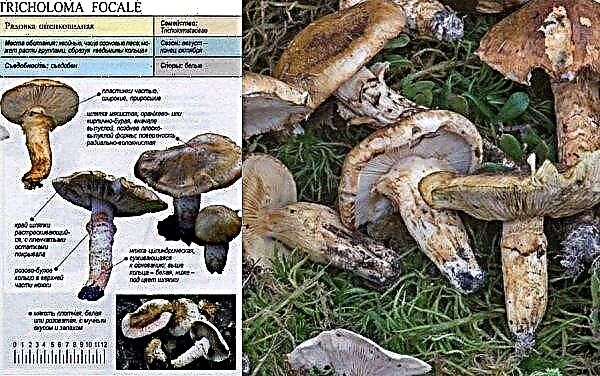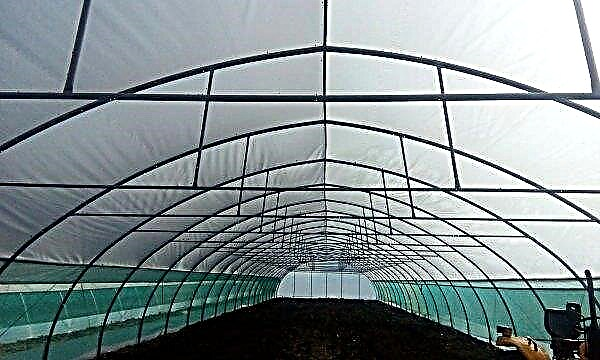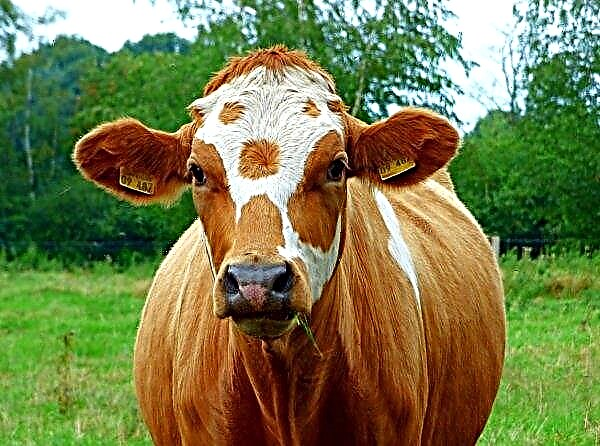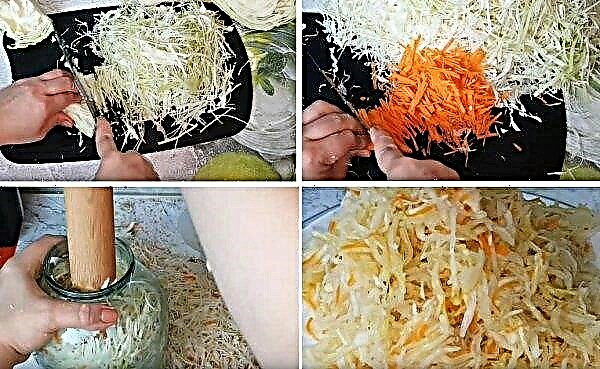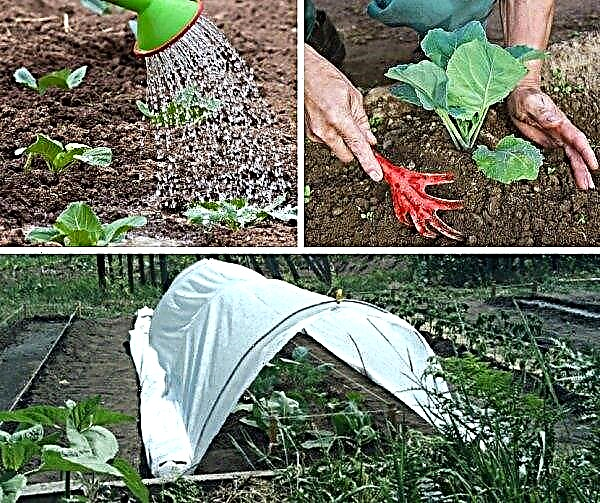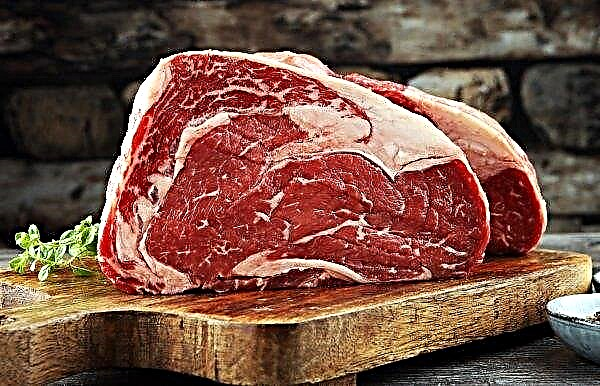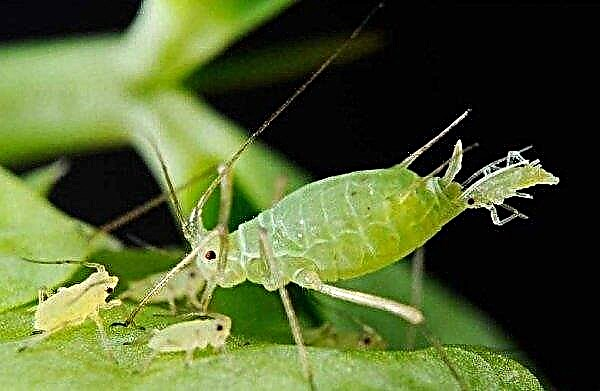Gardening of territories is a popular direction in their landscaping, and this applies both to private household plots and public park areas. Landscape designers use a variety of ways to decorate such territories, but, as a rule, flowering bushes and trees are key elements. Whether they really are appropriate in the landscape and which varieties should be paid attention in the first place - this will be discussed later.
Advantages and disadvantages of trees and shrubs in landscape design
With the moderate use of green spaces and their proper distribution in the territory, there will be no particular shortcomings in the planting of trees or shrubs for the purpose of landscaping, but this question should not be approached carelessly. To assess all the strengths and weaknesses of vegetation in landscape design, you need to carefully study each characteristic.

- The list of advantages of such a solution should include the following:
- durability of green scenery - once planted plants will delight you for decades;
- minimal care (most trees and bushes can be called unpretentious to care for, and all that is needed from the gardener is to occasionally feed vegetation and cut off excess shoots for decorative or sanitary purposes);
- formal-classical view of the garden (if you do not clutter up the space with extra dimensional vegetation, then its appearance will never get bored);
- protection from prying eyes and the possibility of dividing a large territory into more secluded zones, for which tall trees and wide shrubs are great;
- the possibility of decorating the site not only with classic flowers, but also with larger flowering plants (some varieties of shrubs are almost completely covered with unusually large and lush flowers);
- maintaining a high decorative garden even in winter, which only requires the use of evergreen, fast-growing conifers, planting them in groups, in the most advantageous compositions (it is possible to achieve the maximum positive effect from this decoration thanks to structural planting, such as “living walls”).
Did you know? The art of ennoblement of parks and garden areas using this or that vegetation originates in the 8th – 10th centuries BC. e. and is associated mainly with Ancient Greece. The essential attributes of public parks and private estates of that time were straight paths, vases and sculptures, and trees and shrubs were located between them.
- Among the disadvantages of using bushes and trees in landscape design projects, the following points should be highlighted in the first place:
- limited use of floral accents, due to the short flowering of most crops;
- not everyone likes the classic design of the garden;
- the difficulty of observing the ratios of scaling, mass and other compositional means for the most positive result;
- the need for bold and unexpected, often original solutions for a non-standard solution to the problem (this is what is required from a landscape designer, and using only bushes or trees complicates the task);
- the need for a harmonious combination of vegetation with the house and other buildings on the site (too tall trees and a large number of shrubs can cover structures);
- the need for a careful selection of contrasts according to the shape of leaves, silhouettes, texture, in compliance with the rules of deep contrast (no plant should be lost against the rest, which is sometimes difficult to achieve).
 Despite the presence of some disadvantages of landscaping with the use of trees and shrubs alone, it is not worth considering that when they dominate the garden will suddenly become dull and dull. The species and varietal diversity of deciduous and evergreen plants is so vast that it is quite possible to find completely unexpected exotic forms and colors, it would seem, in completely inconspicuous crops.
Despite the presence of some disadvantages of landscaping with the use of trees and shrubs alone, it is not worth considering that when they dominate the garden will suddenly become dull and dull. The species and varietal diversity of deciduous and evergreen plants is so vast that it is quite possible to find completely unexpected exotic forms and colors, it would seem, in completely inconspicuous crops.
Criteria for choosing trees and shrubs for landscape design
The choice of trees or shrubs for use in landscape design should be based on some principles that guarantee the possibility of their maximum use in the future.
The key criteria in this case will be:
- possible functionality of one or another instance;
- its compatibility with another plant or group of plants;
- dimensions of adult plants;
- focus on their growth.
Functions
The functionality of any bushy or tree-like culture is its ability to advantageously complement a specific section of the garden or house territory. So, for open areas, you can use large bushes and trees, and for decorating the gazebo or pergolas, it is better to choose more compact varieties, bizarre shapes (it is possible to use shrubs with liana-like shoots). Evergreen arborvitae or individual spherical bushes are often planted along paths or on the border with neighbors.
Video: Ornamental trees in the garden
Compatibility with other plants
An excessive amount of trees or large, bushy bushes will hide other decorative elements of the site from the eyes, giving the impression of an impassable jungle. For this reason, if trees already grow near the house, then it is better to supplement them with medium-tall shrubs that harmoniously fit into the overall picture.
Important! When choosing a pair for a particular tree or bush, it is worth considering the possible seasonal changes in these plants. It is very desirable that during group planting the life rhythms of the cultures used at least partially coincide.
It is possible to build an ensemble of plants according to the principle of contrast, when varieties with a different set of characteristics visually interact with each other. Contrast can capture several characteristics at once (for example, the shape of a bush, the size of the leaves, the color or the shape of inflorescences), or focus on only one of the listed criteria.
The combination of plants, based on the shape of their crown and leaves, as well as the abundance and brightness of flowering, always has meaning. For example, thuja and spirea, buzulnik and decorative cereals will be beneficial to contrast among themselves.

Dimensions
The sizes of crops selected for landscaping also play a significant role in landscape design. In small areas, the main emphasis can be made on bushes, and in large areas - use a variety of group plantings of trees.
It is better to start filling the projected volume with vegetation from the largest available specimens, gradually adding medium and smallest ones to them. Acting in the reverse order is much more difficult, not to mention the fact that such a solution will be devoid of any logic.
The most balanced composition will be obtained if the number of specimens grows with decreasing significance of the structural element, that is, when group planting small bushes should be more than large trees.
Growth focus
If the crown of most ornamental trees is spherical or vertical, then the shrubs can have almost horizontal shoots. The division of the bushes into groups depending on the direction of growth of the branches also helps to select the most profitable pairs from among other plants.

Vertical bushes resemble trees, as they have a well-defined stem part and a clearly defined crown (for example, hawthorn). They are best planted next to lower, spherical "relatives", because in combination with trees they can visually "drown out" each other.
The crown width of horizontal shrubs is much larger than the height of their stem; branches are located almost horizontally in relation to the soil line. A horizontal example of this group can be considered horizontal juniper, which, unlike vertical bushes, perfectly complements woody plants.
Recommended Reading

Under the concept of "spherical bushes", you can combine all varieties of shrubs with a round crown, such as lilac or viburnum.
They combine well with the previous two species, although in this case a lot depends on the location of a particular culture.
Using trees and bushes with different directions of shoot growth, it is possible to equip the space of a personal plot, creating real art masterpieces from seemingly ordinary cultures.
Popular trees and shrubs for landscaping
The sophisticated landscape and varietal diversity of trees and bushes is difficult to understand even for a sophisticated landscape designer, let alone beginners in this matter. By and large, no one is obliged to know the characteristic features of absolutely all plants, it is enough to pay attention to the most popular of them.
Video: Garden Planning Rules
Trees
Achieving the most positive result from decorating a site with woody cultures is possible only if each selected specimen has some attractive feature of its appearance. An example of such plants with a “twist” will be the species described below.
Did you know? In some regions of Japan, maple leaves are not only a decorative element, but also a good ingredient for cooking. They consider good snacks there. leaves, deep fried; however, first they have to be kept for about a year in containers with salt, and then cover with a special sweet dough.
Japanese maple
This medium-sized tree, up to 10 m high, in the culture may have the form of a bush. What exactly will grow in your territory largely depends on the success of forming pruning at the initial stages of seedling cultivation.

Maple branches are always characterized by an attractive reddish-gray color, with a smooth, non-cracking bark on their surface. Serrated at the edges, rounded leaf plates can grow up to 8-15 cm in diameter and usually have dissections up to half of these values.
In autumn, the surface of the usually green leaf becomes orange-scarlet, with small yellow patches throughout the area. The flowers are always bright, purple-red in color, blooming in April, even before the appearance of leaf blades.
Three-centimeter lionfish (fruits) always hang under the leaves, can be pubescent or devoid of pubescence. Based on the shape and pubescence of the individual parts of the maple, several of its subspecies are distinguished, and individual varietal variations of this plant can change the variegated color of their foliage up to three times in one season.
Aralia
Aralia is called mid-growth deciduous trees, with a spiky trunk and branched crown top, although some species are represented by large perennial shrub forms or even grassy crops. The height of woody cultivated plants usually ranges from 2-10 meters, although even 20-meter-high specimens are found in the natural environment of growth.
Their shoots, leaves and inflorescences are almost always completely bare. Leaf plates are alternate, large, without stipules, twice or thrice pinnate, densely collected closer to the top of the crown, which makes the plant look like a palm tree.

Numerous umbrellas form large complex paniculate inflorescences. Flowers are bisexual, small, four-, five- or six-membered. The fruit is berry-shaped, spherical in shape, with seeds compressed on the sides. Popular decorative species of Aralia today include California, heart-shaped, Chinese, whose height rarely exceeds 3-5 meters.
Barberry
Trees among plants of the genus Barberry are much less common shrub forms, but are still used in landscape design. Tree-like cultures reach a height of three meters in height, characterized by a predominantly deciduous spherical (less often columnar) crown.
We offer you to find out how spruce and pine are used in landscape design.
Saturated green leaf plates grow in bunches, in the next order. The branches are thin, densely covered with thorns and are located upward at an acute angle. Without regular pruning, the plants may look untidy, as the branches will stick out in all directions at different angles.
During flowering (occurring at the end of spring or the beginning of summer) on the shoots you can notice violet, purple, yellow, white or any other bright shades of flowers that remain on the branches for 2-3 weeks. Toward the end of summer or the beginning of autumn, they are replaced by oval berries of red, burgundy or black. They remain on the tree for a long time, even in winter, highlighting bushes on a white snowy surface.
Shrubs
Shrub forms of plants for decorating the site are much more than woody, so the choice here is wider. The most popular shrubs in domestic gardens today include bladderwort, rhododendron, stefanander, hydrangea, spirea, jasmine. Each of them has its own characteristics of appearance and cultivation.
Bubble
This plant belongs to the Rosacea family and is represented by decorative deciduous shrubs 1-3 m high. Bubblecrop can be used both in single and in group plantings, not to mention the possibility of creating hedges.

The plant reaches its maximum decorativeness during flowering, when white or pink flowers appear on brown-brown shoots with ovoid or elliptical dark green leaves, collected in slightly convex corymbose inflorescences.
The peak of flowering occurs in early July, but the first buds appear at the end of June and since then remain on the plant for 2-3 weeks. After them, miniature bubbles collected in shields are formed on the branches. It was the unusual shape of the berries of the shrub that served as the reason for its non-standard name.

Stefanandra
Another representative of the Rosaceae family, which, like the previous version, is presented in the form of a wide, deciduous shrub reaching a height of 2.5 m. Due to the small annual growth (not more than a few centimeters), the maximum values will be relevant for plants only after decades of growing on site, so many of them are characterized by more modest sizes.
Check out

The edges can be smooth or complemented by rare teeth, sometimes strongly dissected on the apical part. The color of the leaves varies from bright green in the summer to yellow-orange in the fall.
Flowering of the bush begins with the advent of summer and continues until August. All flowers are small (up to 5 mm), collected in sparse inflorescences. The fruits ripen in September - October and begin to unfold in their lower part. As soon as the hole is large enough, small spherical seeds begin to spill out from within (in one ovary a pair of seeds is formed immediately).
Rhododendron
Evergreen, semi-deciduous or deciduous shrubs (rarely small trees) of this genus are represented by more than a dozen varietal varieties, but most often the plants do not grow above 2-meter height, keeping the crown diameter within 1.5–2 m. Based on the variety, leaf plates can be very different in shape and size: alternate, whole-edge, ovate, obovate, sometimes serrate.
The buds that appear during the flowering period soon open into bisexual flowers, with a large corolla of irregular shape. They are collected in thyroid inflorescences or brushes, less often located singly or in two pieces. The fruit is a five-leaved polyspermous capsule, opening in the direction from top to bottom. Rod-shaped seeds are 0.5–2 mm long. In the natural environment of growth, rhododendron grows both singly and in groups, often forming thickets.

Hydrangea
Hydrangea shrub belongs to the genus Gortenziev, where in total there are about fifty species. In Russian gardens, mainly large-leafed (also known as garden) hydrangea is found, characterized by lush and abundant flowering.
The color of the flower petals can be any: white, pink, peach, red and even purple or blue. Inflorescences are panicled or spherical, but in any case they will become a real decoration of the garden, as they are clearly visible on the saturated green background of oval, pointed at the end of the leaves with serrated edges.
The central brown-brown shoots are located strictly vertically, and the lateral ones are protruding, rushing mainly to the side. At the peak of its flowering (usually in the middle of summer), hydrangea bushes are densely covered with inflorescences, which gives the plant maximum elegance.
Spirea
Spirea deservedly fell into the group of the most famous ornamental shrubs for Russian gardens. Depending on the variety and species, these can be very dwarf, low plants (up to 50 cm tall), and vertical tall specimens, which are often used to create hedges.
Important! When choosing a variety of spirea suitable for the garden, it is worth considering the period of its flowering: in the southern regions you can plant spring varieties, and for the central regions of Russia it is better to choose varieties with long-lasting summer flowering until autumn.
Thin leafy shoots can be located both strictly vertically and with a bend, acquiring a weeping shape. In some cases, the crown of the tree can be cascading, round or spherical, but in order for it to retain its shape for a long time, in most cases a regular forming pruning is required.
Spirea leaf blades are pairwise spaced, often elongated ellipsoid in shape, with a sharp point at the end. The color of leaves varies from green-gray or more saturated tones of green in summer to orange with a red tint in autumn, which guarantees high decorativeness of spirea at any time of the year.

Jasmine
Jasmine is usually represented in the gardens by erect or curly spreading shrubs, with thin and smooth shoots covered with triple simple leaves of a dark green color. At the ends of the central branches there are large flowers of regular shape, collected in corymbose inflorescences (based on the type of plant, they can be lateral or clearly apical).
The color of the flowers also varies depending on the variety of culture, but in most cases you can find white, pink and yellow buds. It is noteworthy that the specific shade of the flower largely depends on the area in which it grows, as well as on the acidity of the soil.

How to apply trees and shrubs in landscape design
In the design of the territory by plants, the main task will be to create a logical and harmonious landscape with the necessary proportions of the objects used.
To plant trees and shrubs as decorative as possible, when creating groups do not use the same elements, that is, when allocating zones for arranging flower beds in an open area, you should not choose the same sizes for them, or plant single-sized or single-color plants in the areas (it is good if one color in the composition is primary, and the other two are additional).
It is important to adhere to the "law of the circle" in landscape design. If you divide an imaginary figure vertically into two parts, then on the right should be warm shades of the palette, and on the left - cold. It is desirable that the main compositional elements are present in one group of colors.

This does not mean that the color palette from different parts of the composition cannot be mixed, but the specific color from the opposite group can act as an accent that attracts attention (usually contrasting group plantings are designed to distract attention from the fence, individual parts of buildings and other unattractive parts of the site).
Check out

Separately, it is worth highlighting the so-called "law of the square." Despite the fact that in the limited space of a small country courtyard or mini-garden there is nowhere to turn around particularly, this law still affects planting. In this case, you should focus on the cardinal points.
The tallest landscape design elements (trees and large shrubs) better placed on the north sideso that the rest of the space receives enough sunlight (this visually increases the area).
It is good if such plants have a high level of shade tolerance, since the northern areas are always more shaded than the southern ones.
About two or three meters from this zone of light, there is more light, which means that it is possible to plant photophilous cultures of more compact sizes. To make the garden as original and unusual as possible, it is worth choosing the appropriate design style, the so-called "regular".
The main difference between this option and the rest is the geometrically correct forms of landings, which are based on the following principles:
- The crown should be as even as possible, for which the leaves and branches of bushes or trees are carefully trimmed.
- All selected plant varieties should tolerate a haircut (for example, Western thuja, small-leaved linden, hawthorn, shrimp, common juniper, yew berry, boxwood).
- If there are paths, it is better that they are straight, and the beds are symmetrical. If the severity of forms is not to your liking, it is worth giving preference to landscape gardens, with the absence of even and clear lines.

The landscape style of the site design provides for the creation of compositions that are as close as possible to the natural conditions for the growth of trees and shrubs. When planting plants, it should be borne in mind that at the forest edge or in the burs, bushes and trees do not grow in strict geometric order.
In addition, there is no need to use only coniferous or only deciduous crops, because mixed plantings, with the absence of plants with evenly trimmed crowns, are much closer to the natural conditions of growth.
In one planting, spruce, thuja, juniper and hawthorn can be perfectly combined with each other, and a bubble plant or a snow-berry will help to "dilute" their company. The dark green needles of juniper will also perfectly highlight the light foliage of barberry.
As you can see, trees and shrubs can really become key elements in any landscape design, favorably complementing the grassy and flowering crops on the site. Therefore, adhering to the general rules of a single or group landing, there is every chance to green the house territory for many years.

